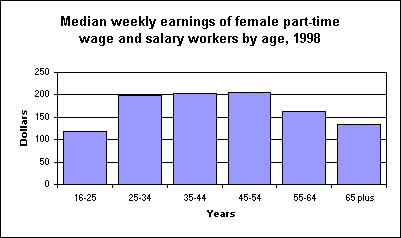An official website of the United States government
 United States Department of Labor
United States Department of Labor
Women who worked part-time—less than 35 hours per week—made up about one-fourth of all female wage and salary workers in 1998. Their median weekly earnings were $161, about 35 percent of the median for women working full-time. Earnings for men who worked part-time were $146. That was 9.3 percent lower than female part-timers’ earnings.

[Chart data—TXT]
Unlike full-time workers, whose earnings increased for each successive 10-year age division within the 25-to-54 year category, weekly earnings for female part-timers were essentially the same regardless of age. Female part-timers younger than 25 or older than 55, however, earned less than did those in the central age groups.
Also in contrast to full-time workers, weekly earnings for both male and female part-timers varied little by race or Hispanic origin.
These earnings data are a product of the Current Population Survey. For more information, see "Highlights of Women’s Earnings," BLS Report 928.
Bureau of Labor Statistics, U.S. Department of Labor, The Economics Daily, Earning patterns for women working part-time contrast with full-timers’ at https://www.bls.gov/opub/ted/1999/may/wk2/art05.htm (visited July 30, 2025).

